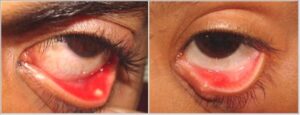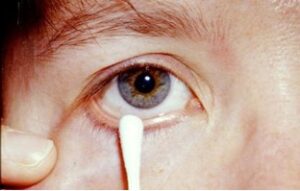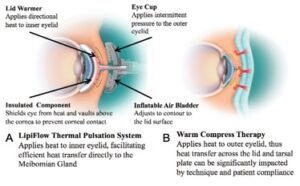By Prof. Somsanguan Asanyakhun
Head of LASIK Center Faculty of Medicine Chiang Mai University
What are the symptoms of inflammatory eyelid disease?
If you have these symptoms often, you may have a problem with blepharitis.
1. Eyes are stye.
2. Swollen, red eyelids with pimple-like bumps
3. The edge of the eyelid has a clear blister
4. Red eyelids with crusts or scabs around the eyelashes.
5. Gray eyelashes
6. Dry eyes, red eyes, itchy eyes, burning eyes, watery eyes

How dangerous is blepharitis?
The eyelids are not only responsible for protecting the eyeball. There are also sebaceous glands and sweat glands at the base of the eyelashes. which, if infected, will cause an external hordeolum, there is also a sebaceous gland (meibomian gland) on the eyelid shaft Which, if infected, will cause a type of stye in the head (Internal hordeolum), which, if often inflamed will cause harm to the eyelash roots As a result, the eyelashes are raised.

Meibomian glands produce the lipid layer of tears. This helps the tears not evaporate quickly. Therefore, when there is frequent inflammation will cause abnormal functioning (meibomian gland dysfunction or MGD) which causes less fat production It causes tears to evaporate quickly. It causes dry eyes, red eyes, itchy eyes, burning eyes, watery eyes, or excessive fat production. cause inflammation of the eyelids causing red eyelids Eye stains or flakes around the eyelashes

Why does inflammatory eyelid disease occur?
There are many factors that cause eyelid inflammation, including exposure to dirt around the eyelids such as dust, eyeliner. false eyelashes Eyelid tattooing, etc., wearing contact lenses eye allergy Including diseases of the body system such as autoimmune disease Menopause Receiving certain medications, including antihistamines, antidepressants Medications to treat enlarged prostate, etc.
How to treat eyelid inflammation?
Methods for treating eyelid inflammation include:
1. Maintain eyelid health :
1. Using baby shampoo or eyelid cleaning products in particular This may be in the form of a foam or a gel or a cotton pad moistened with a solution by wiping the edge of the eyelid at the opening of the sebaceous gland. to remove fat and germs that accumulate in that area

2. Using a device that can heat to about 40 degrees Celsius, takes 5-15 minutes, done 1-2 times a day, which may be a cloth soaked in warm water, boiled eggs, a hot water bag, or a finished product such as blepharosteam, hot moist air, eye warmer. mask etc.

3. It is pressed and rolled along the orientation of the sebaceous glands to allow the clogged fat to drain out. using their own fingers Or may use assistive devices such as tweezers, glass bulb rods or finished products such as Lipidview etc.

2. Use antibiotics to destroy germs that accumulate in clogged sebaceous glands. which consists of
1. These may come in the form of eye drops, gels, or eye ointments such as Azithromycin, metronidazole, fucidic acid, etc.
2. These include Azithromycin or tetracyclines.
3. These include steroids or cyclosporine, for example.
4. Use artificial tears to lubricate the eye surface, which tends to dry out due to the rapid evaporation of tears. and helps flush substances that stimulate inflammation Which should use the type without preservatives if it has to be used more than 4 times a day and should use the type that contains fat as an ingredient to replace the reduced fat layer
5. Surgery to open the holes of the sebaceous glands on the eyelids.
6. Including blockage of the tear duct Removing or tickling the eyelashes eyelid correction surgery to prevent eyelashes from rubbing the cornea, use of intense pulsed light, etc.

 You can contact us for information at the LASIK Center, Faculty of Medicine. Chiang Mai University
You can contact us for information at the LASIK Center, Faculty of Medicine. Chiang Mai University
Tel. 0-5393-9777 Call center 08-2766-6909 or www.facebook.com/cmulasik
Professor Somsanguan Asankhun
Department of Ophthalmology Faculty of Medicine
Chiang Mai University
